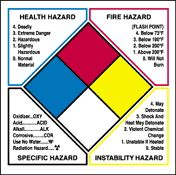 |
 |
| MSDS Topics |
Free Sites | FAQ's | Regulations | Glossary | Software | Suppliers |
| Books | Forum | Poll | Fun stuff | Quiz | Store | |
| MSDS and safety supplies | Search ALL our MSDS info | |||||
 | |||
 |
 |
 |
|
| Title: 02/02/1994 - Labels and hazard warnings. | |
| Record Type: Interpretation | Standard Number: 1910.1200 |
February 2, 1994
Mr. Michael Strong
Industrial Hygienist
Wacker Silicones Corporation
Adrian, Michigan 49221-9397
Dear Mr. Strong:
This is a response to your letter of October 5, concerning the requirements under the Occupational Safety and Health Administration's (OSHA) Hazard Communication Standard (HCS), 29 CFR 1910.1200, for labeling provisions.
You asked two questions that were a follow up to your July 30 letter. Reinterated below are your submitted questions with answers in the order that they were presented in your letter.
The label warning language does not need to match the language on the MSDS word for word nor does it need to address every hazard listed on the MSDS. Sections (f) and (g) of the HCS address container labeling and MSDS respectively. There is no requirement for a word for word translation between the label and MSDS. The purpose of a label is to provide an immediate warning to employees of the hazards they may be exposed to and through the chemical identity, labels provide a link to more detailed information available through material safety data sheets and other sources.
OSHA's compliance directive Inspection Procedures for the Hazard Communication Standard, (CPL 2-2.38C) discusses the issue of appropriate hazard warning. The directive states that:
|
"It will not necessarily be appropriate to warn on the label about every hazard listed in the MSDSs. The data sheet is to address essentially everything that is known about the chemical. The selection of hazards to be highlighted on the label will involve some assessment of the weight of the evidence regarding each hazard reported on the data sheet. Assessing the weight of the evidence prior to including a hazard on a label will also necessarily mean consideration of exposures to the chemical that will occur to workers under normal conditions of use, or in foreseeable emergencies. However, this does not mean that only acute hazards are to be covered on the label, or that well substantiated hazards can be left off the label because they appear on the data sheet." In your words then, label warning language must contain the appropriate warnings but the language used in those warnings does not have to be identical to the language used in the MSDS. |  Communicate workplace hazards with handy labels from Safety Emporium. |
For example, which two of the following four choices are more appropriate hazard warnings? A. Causes vasomoter rhinitis B. Causes nasal irritation C. Causes symptomatic ventricular arrhythmias D. Causes irregular heart beat which may be fatal if not controlled.
Sincerely,
Ruth McCully, Director
Office of Health Compliance Assistance
October 5, 1993
Ruth McCully, Director
Office of Health Compliance Assistance
Occupational Safety and Health Administration
U.S. Department of Labor
200 Constitution Avenue N.W. Rm. N 3468
Washington, DC 20210
Dear Ms. McCully:
Thank you for your response (drafted by Mr. Thomas Galassi) to my questions on the Hazard Communication Standard 29 CFR 1910.1200 for labeling provisions.
There are still two points on which I desire clarification, which were in my original letter, but which were not directly answered in your reply.
|  When you work around chemicals be sure you have a safety station like this one from Safety Emporium. |
Please provide general written guidance addressing these two issues specific to proper interpretation of the standard.
Sincerely,
WACKER SILICONES CORPORATION
Michael C. Strong
Industrial Hygienist
The official, public domain, OSHA version of this document is available at http://www.osha.gov/pls/oshaweb/owadisp.show_document?p_table=INTERPRETATIONS&p_id=21391&p_text_version=FALSE